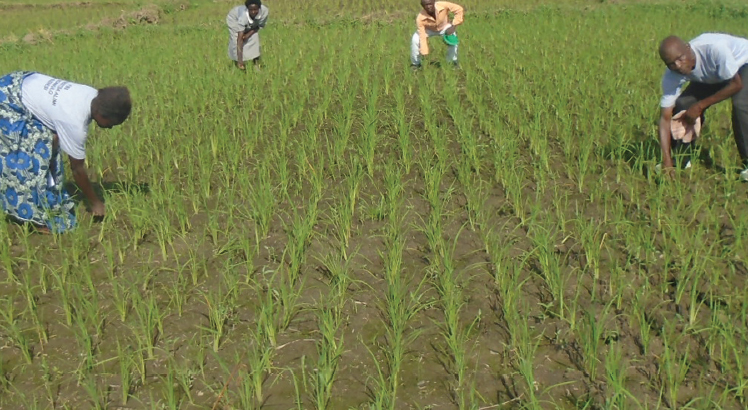Rice farmer Bryony Mywanga of Yembe Trading Centre in Karonga shines a light on the benefits of a new rice planting system, writes our Staff Writer James Chavula
With just four percent of Malawi’s rural majority connected to grid power, Bryony Mywanga, 43, feels lucky to finally have electricity which powers his four children’s education, family entertainment and wife’s business.
After a bumper rice harvest in May last year, the farmer lifted power lines across seven poles from Yembe Trading Centre in Karonga to his hilltop residence half a kilometre away.
“Electricity helped my children, Gideon and Christina, to study in peace for Primary School Leaving Certificate of Education examinations. They waved goodbye to eye-straining yellowish glows and smoky fumes from kerosene lamps as well as costly batteries for torches,” he says.
Farmers tend to a rice crop
The lightbulbs in the house surrounded by unelectrified homesteads expose the benefits of planting kilombero rice in rows, a seedling per station.
The National Smallholder Farmers’ Association of Malawi (Nasfam) introduced the system of rice intensification, called SRI, as part of the climate-smart agriculture project funded by Irish Aid. The initiative helps farmers harvest more despite climate change.
Mywanga, the chairperson of 22 lead farmers, mentors 60 farmers to harvest more as the rainy season often starts late and ends before crops are ready for harvesting in the paddies of Karonga North.
“Climate change is a wake-up call for farmers to embrace modern techniques because old ones won’t produce new results,” he says.
In 2018, Mywanga stopped broadcasting recycled rice seed in six of eight plots in his two-acre rice field. Instead, he buys 10 kilogrammes (kg) of certified seed from Nasfam at K800 per kg and sows it in rows on a bed where it fledges for 14 days. After two weeks, he transplants the seedlings to six plots along Yembe stream, planting one per station like the sasakawa method of planting maize.
“Astonishingly, I now harvest three to four 120kg bags from each plot while the remaining two, still dedicated to the traditional planting method because I cannot afford casual workers, produce just one or two bags,” he says, splitting the difference.
SRI has reduced the seed requirement to just a tenth of what he used to scatter previously.
“Currently, I use 3.5kg of certified seed on an acre that previously took 35kgs of recycled seed. Then few seeds germinated and the yield was low,” Mywanga recalls.
Apart from electrifying his house, he has acquired eight cows, eight goats, three pigs and 35 chickens, which produce manure for his maize, rice and cassava fields. Just like that, they have cut back on chemical fertiliser, which cost K40 000 a bag.
“Manure is almost free and continuously enriches the soil unlike chemical fertilisers, which I cannot afford,” he explains.
His kilombero yield has since doubled to 12 bags per acre.
He counts the gains: “In the first year, I yielded six bags which I sold to Nasfam and bought two bulls to pull my plough. I no longer use a hoe or rely on friends’ ox, which can be busy when I need them.
“The second year, I added two bedrooms and a sitting room to my house. I also replaced a grass thatch roof with iron sheets.
“This year, I electrified my house to follow current affairs on TV, keep my phone fully recharged and make sure schoolchildren do not stop studying shortly after sunset.”
And electricity means more time for children to study and the family to bond while getting entertained.
“We no longer sleep in the dark or endure long walks to recharge our phones at the trading centre. When I am free from farm activities, I follow sports news on TV and on the phone,” Mywanga explains.
The phone does not only connect him with relatives, friends, fellow farmers and clients.
“It is my bank. I send and receive money with ease. I used to spend K1 500 to get to a brick-and-mortar bank at Karonga Town,” he says.
The rice grower also receives farming tips from extension workers via the mobile phone.
From rice farming, Mywanga paid fees for his daughter at Kaporo Secondary School.
“My vision is to make my family self-sufficient here in the village and enjoy the quality life that lures some people to cities and towns,” he explains.
Mywanga’s wife runs a grocery at Yembe Trading Centre along the Northern Corridor to neighbouring Tanzania. The shop makes a profit of about K65 000 a month, he says. She also earns about K30 000 a month from selling tomatoes, onions and other vegetables.
“Given the scorching sunshine in our shoreline setting, I want to buy a fridge and start selling bottled water and cold drinks to passers-by,” she says.
The post Beyond rice and lights appeared first on The Nation Online.
 Moni Malawi
Moni Malawi 

